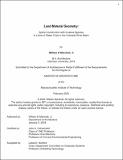| dc.contributor.advisor | Ochsendorf, John A. | |
| dc.contributor.author | Marshall Jr, William D. | |
| dc.date.accessioned | 2024-03-21T19:12:15Z | |
| dc.date.available | 2024-03-21T19:12:15Z | |
| dc.date.issued | 2024-02 | |
| dc.date.submitted | 2024-02-22T22:01:39.644Z | |
| dc.identifier.uri | https://hdl.handle.net/1721.1/153870 | |
| dc.description.abstract | This thesis speculates architectural systems that act in reciprocal and reparative relationship with the local environment and ecology rather than extractive means. It suggests material sourcing tamarisk, an invasive species in southwestern desert river systems that exacerbate strains on water availability, thus, removing the plant, yet maintaining its sequestered carbon as construction material. Active bending of this raw natural timber allows for a low tech means to approximate structural geometry for adobe construction. | |
| dc.publisher | Massachusetts Institute of Technology | |
| dc.rights | In Copyright - Educational Use Permitted | |
| dc.rights | Copyright retained by author(s) | |
| dc.rights.uri | https://rightsstatements.org/page/InC-EDU/1.0/ | |
| dc.title | Land Material Geometry: Spline Construction with Invasive Species in a time of Water Crisis in the Colorado River Basin | |
| dc.type | Thesis | |
| dc.description.degree | M.Arch. | |
| dc.contributor.department | Massachusetts Institute of Technology. Department of Architecture | |
| mit.thesis.degree | Master | |
| thesis.degree.name | Master of Architecture | |
